The Kesar mango, often referred to as the 'Queen of Fruits,' captivates with its luscious sweetness and numerous health benefits, making it a valuable addition to any garden. This guide explores essential techniques for planting and nurturing Kesar mango trees, enabling enthusiasts to enjoy the rewards of this tropical delight. However, as with any gardening endeavor, challenges may arise—how can one successfully cultivate this cherished fruit while avoiding common pitfalls? Discover the steps to effective Kesar mango cultivation and unlock the secrets to thriving trees that produce delicious, nutritious fruit.
🥭 Thinking about growing a Mango Tree in your garden?
Explore Kesar Mango tree for sale at Everglades Farm - shipped directly from Florida.
1. Understand Kesar Mango: Characteristics and Benefits
This variety, often celebrated as the 'Queen of Fruits,' is recognized for its sweet, fragrant taste and smooth, fiberless texture. Typically medium-sized, the kesar mango showcases a saffron-yellow skin when ripe, making it both visually appealing and delicious. Nutritionally, these fruits are a powerhouse, rich in vitamins A and C, which are essential for bolstering immunity and supporting healthy vision. Per 100 grams, this fruit contains approximately:
- 60 kcal
- 36.4 mg of Vitamin C
- 0.9 mg of Vitamin A
Additionally, the presence of pectin, a type of fiber found in these fruits, aids in lowering cholesterol levels and promotes digestive health.
Thriving in warm, tropical climates, these trees flourish under full sunlight and require well-drained soil for optimal growth. Their moderately vigorous growth habit results in a dense canopy, which can be effectively managed through regular pruning to enhance fruit production. Primarily cultivated in the Gir region of Gujarat, kesar mango fruits have gained popularity not only for their exquisite flavor but also for their health benefits, making kesar mango a valuable addition to any garden or diet. Notably, this variety was the first agricultural product from Gujarat to obtain a GI label, underscoring its authenticity and significance.
With an impressive 88% positive rating from customer reviews, these fruits are not just a delight but also a superfood that can enhance overall well-being. However, moderation is key, as excessive intake may lead to increased body temperature and digestive issues. With their rich nutritional profile and delightful taste, these fruits are essential for any fruit enthusiast.
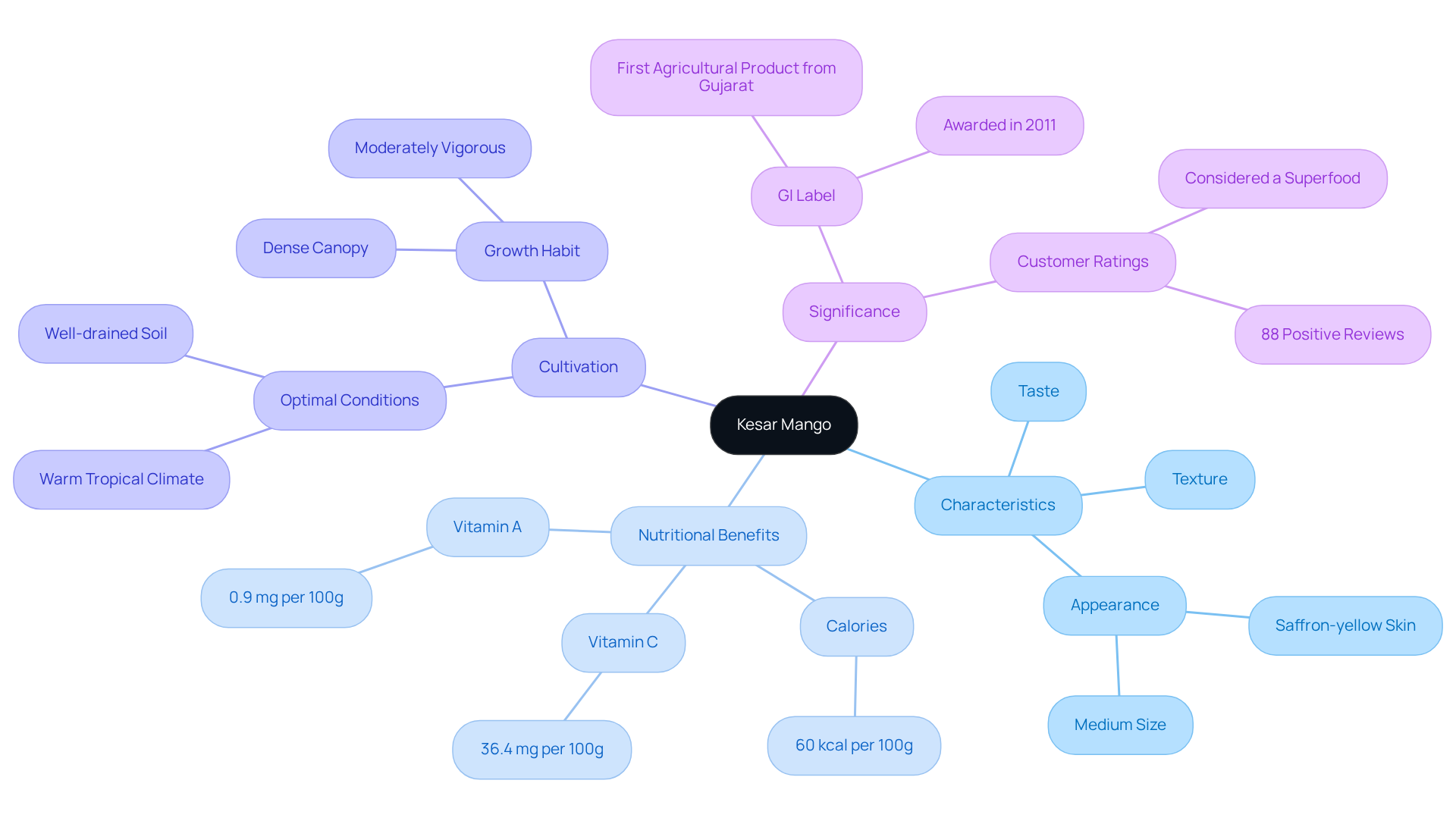
2. Gather Tools and Prepare Your Garden for Planting
To effectively plant your Kesar mango, begin by gathering the necessary tools:
- A shovel or spade
- Garden trowel
- Earth amendments like compost
- Mulch
- A watering can or hose
- A balanced fertilizer
It is essential to choose a sunny area in your garden that receives a minimum of 6-8 hours of direct sunlight daily, as this is crucial for the plant's development.
Next, prepare the ground to ensure it is well-draining and enriched with organic matter. The ideal type of soil for Kesar mango fruit-bearing plants is sandy loam or loamy ground, with a pH level ranging from 5.5 to 7.5. A good soil composition includes a mix of sand, silt, and clay to promote strong root growth. Clear the planting area of any weeds and debris to create a clean and conducive environment for your mango plant to thrive. Additionally, incorporate 3-4 inches of compost or well-rotted manure to enhance soil fertility and structure. It is important to maintain stable humidity levels, as this is crucial for the plant's growth and can help prevent issues like premature fruit drop. Finally, ensure deep but infrequent watering to support the young plant's establishment.
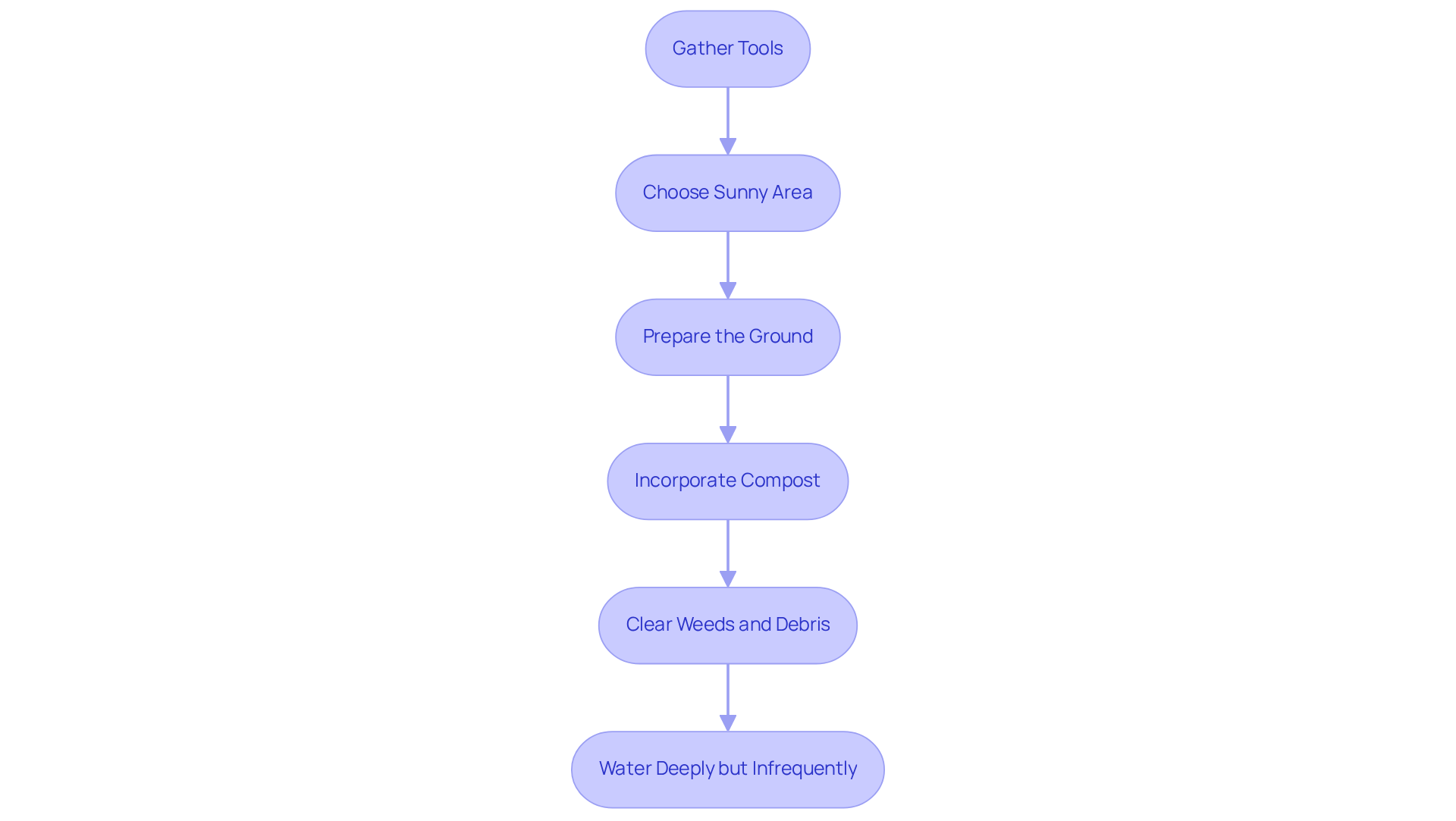
3. Plant Kesar Mango Trees: Step-by-Step Instructions
Select the Appropriate Moment
The ideal time to plant Kesar mango trees is during the rainy season or early spring. This timing ensures that the ground is moist, which promotes robust root development.
Dig the Hole
Create a hole that is approximately 2 feet wide and 2 feet deep. This size provides ample space for the roots to expand and establish themselves effectively.
Prepare the Ground
Enhance the fertility of the soil by mixing the excavated earth with compost. It is crucial to ensure that the pH level remains between 5.5 and 7.5, as this range is optimal for growth.
Plant the Tree
Position the Kesar mango sapling in the center of the hole. It is important that the root ball is level with the surrounding soil to facilitate proper growth.
Backfill the Hole
Carefully fill the hole with the prepared soil mixture, pressing down gently to eliminate any air pockets that could impede root development.
Water Generously
Once planted, irrigate the sapling thoroughly. This helps to settle the soil around the roots and provides the necessary moisture for establishment. Monitor soil moisture levels and adjust your watering frequency as needed, especially during dry periods.
Mulch
Apply a layer of mulch around the base of the plant. This practice helps retain moisture, suppress weeds, and regulate soil temperature, all of which contribute to the overall health of the Kesar mango. Additionally, protect young fruit plants from temperatures below 30°F to prevent damage.
Spacing
When planting multiple fruit trees, ensure they are spaced approximately 12 to 15 feet apart. This spacing encourages healthy air circulation, which is vital for growth.
Soil Treatments
Consider applying soil treatments such as zinc sulfate, copper sulfate, and boric acid. These treatments can enhance fruit yield and improve nutritional quality.
Expert Insight
As gardening specialist Melissa Strauss emphasizes, providing proper care and attention during the planting phase is essential for the long-term success of fruit-bearing plants.
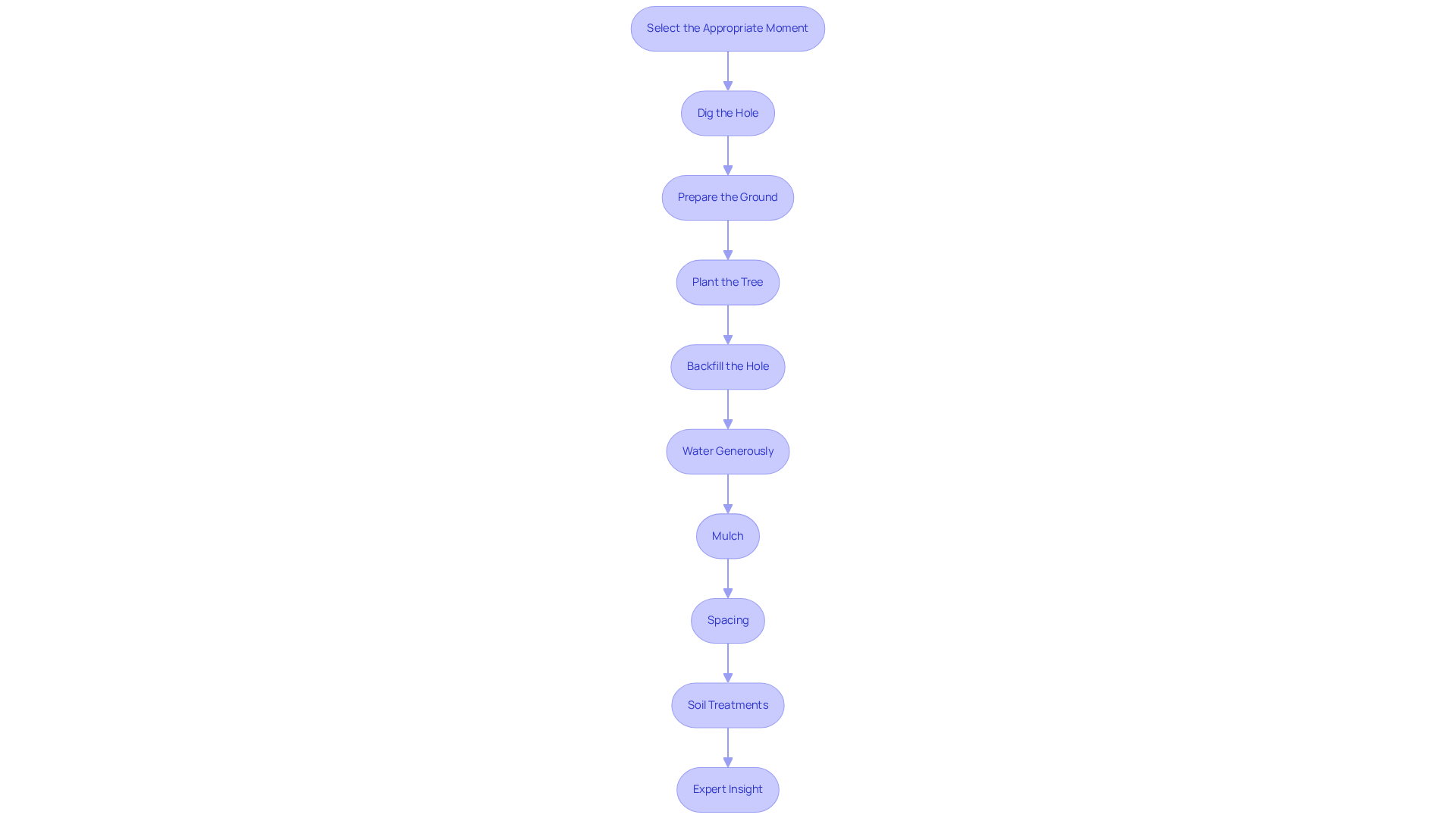
4. Maintain Your Kesar Mango Trees: Watering, Fertilizing, and Pruning
These fruit-bearing plants thrive with regular care, particularly during their formative years. Here’s how to maintain them effectively:
Watering: In the initial three years, Kesar fruit trees necessitate deep watering every 1-2 weeks. It is crucial to allow the top 2-3 inches of soil to dry out between waterings to prevent root decay. This practice not only fosters healthy root establishment but also aligns with sustainable water management strategies. Moreover, implementing a strategic period of moisture stress for 50-60 days can significantly enhance fruit set during flowering.
Fertilizing: To encourage robust fruit development, apply a balanced fertilizer every 6-8 weeks throughout the growing season. Choose fertilizers that are rich in potassium, as this nutrient is essential for improving fruit quality and yield. Incorporating ground treatments such as 100 g of Zinc sulphate and 50 g of Copper sulphate can further enrich the nutritional profile of the fruits. Additionally, maintaining a soil pH between 5.5 and 7.5 is vital for optimal growth.
Pruning: Annual trimming post-harvest is crucial for shaping your Kesar plant and promoting new growth. Concentrate on removing dead or diseased branches to improve air circulation, thereby reducing the risk of disease. Employing effective pruning techniques can greatly enhance fruit yield, resulting in a vigorous and productive plant. Furthermore, pay close attention to pest control, particularly concerning borers, to safeguard the health of your plants.
Mulching: Applying mulch around the base of the plant can effectively limit weed growth and retain soil moisture, further bolstering the health of your fruit trees.
By following these guidelines, you can cultivate flourishing fruit-bearing plants that yield delicious produce while promoting sustainable gardening practices.
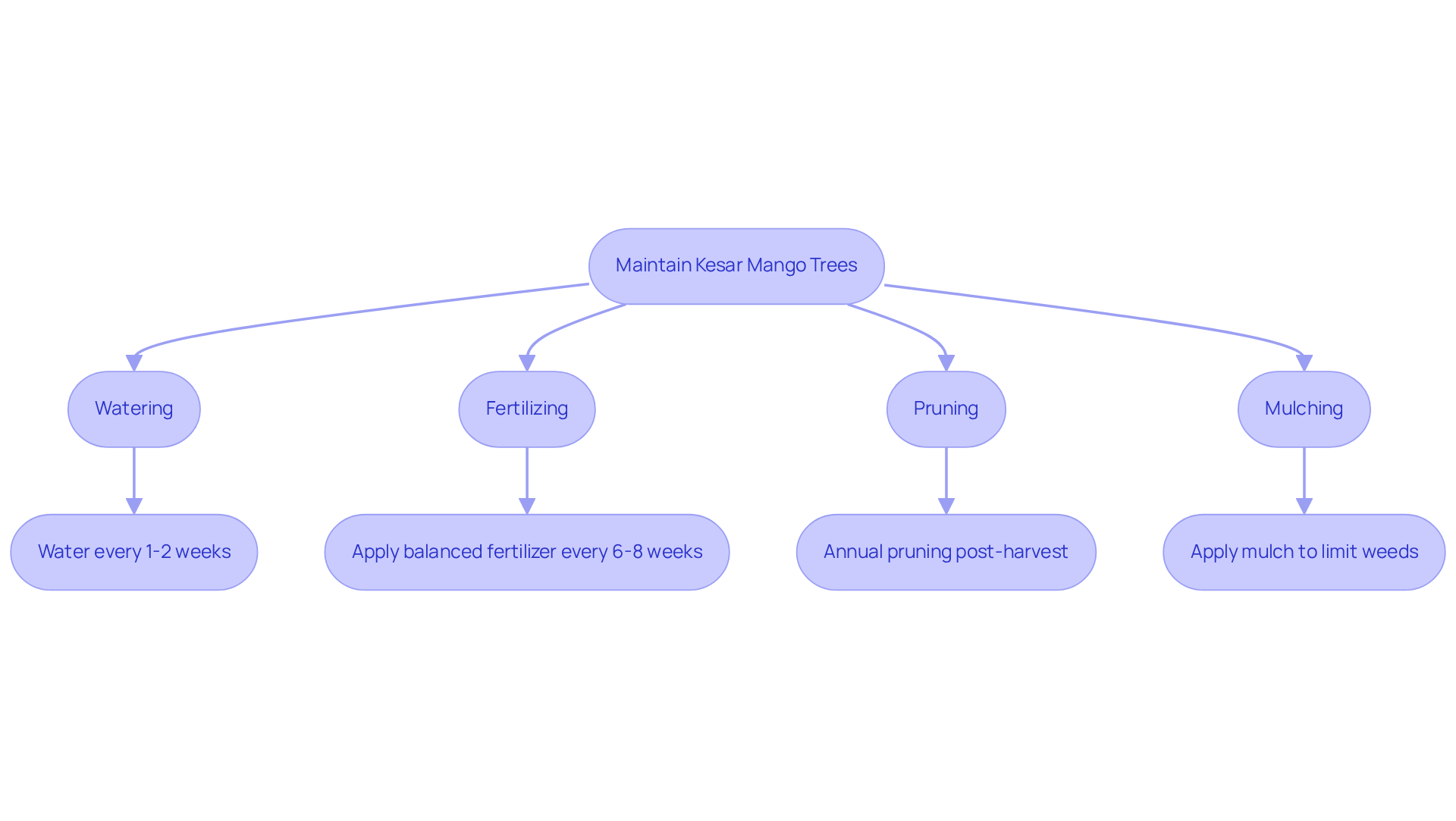
5. Troubleshoot Common Issues in Kesar Mango Cultivation
Common issues in Kesar mango cultivation include:
-
Powdery Mildew: This fungal disease can significantly affect mango trees, leading to reduced fruit quality and yield. To manage powdery mildew, ensure good air circulation around the trees through proper spacing and pruning. Applying organic fungicides, such as potassium bicarbonate or neem oil, can effectively control outbreaks. Regular monitoring is essential, especially during humid conditions when the disease is more prevalent.
-
Fruit Fly: Fruit flies present a significant risk to fruit orchards, resulting in considerable harm and loss. In Africa, approximately 40% of the 1.9 million tonnes of tropical fruits produced each year are lost due to fruit fly damage. Implementing a combination of traps and organic insecticides can help manage these pests. For instance, using McPhail traps baited with methyl eugenol can effectively monitor and reduce fruit fly populations. Additionally, bagging fruits during the growing season has shown to protect them from infestations while improving overall fruit quality. As noted by Shaddai Nakagwa, control measures should be implemented throughout the year to lessen fruit fly population build-up and damage to fruits.
-
Nutrient Deficiencies: Nutrient deficiencies, particularly nitrogen, are often indicated by the yellowing leaves on Kesar mango plants. Performing a ground assessment can assist in determining specific nutrient requirements. According to the findings, enriching the ground with organic fertilizers or compost ensures the plants obtain sufficient nourishment for robust development and fruit yield.
-
Excessive Watering: Proper drainage is essential for mango trees, as excessive watering can result in root rot and other health problems. Adjust your watering schedule according to rainfall and soil moisture levels. Implementing a drip irrigation system can provide consistent moisture without waterlogging the roots, promoting optimal growth conditions.
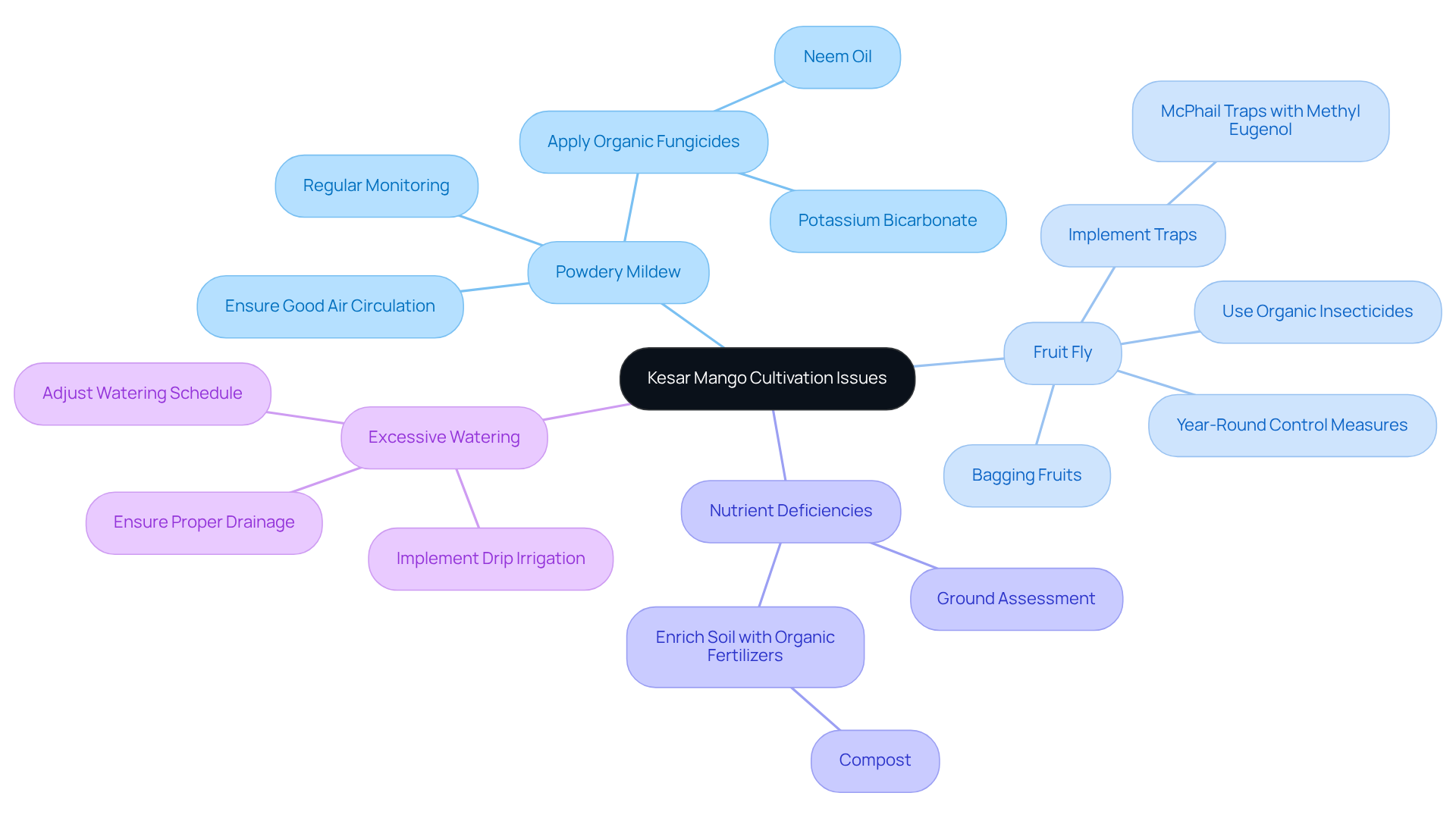
Conclusion
The Kesar mango, often celebrated as the 'Queen of Fruits,' delivers not only a delightful taste but also a multitude of nutritional benefits. This guide has illuminated the essential steps for planting and caring for Kesar mango trees, encompassing their unique characteristics and the intricacies of maintenance. By adhering to the outlined methods, enthusiasts can cultivate these vibrant trees in their gardens, ensuring they thrive and yield delicious fruit.
Key insights include:
- The significance of selecting the optimal planting time
- Preparing well-draining soil
- Providing consistent care through proper watering and fertilizing
Furthermore, addressing common cultivation challenges such as pest management and nutrient deficiencies is vital for maintaining healthy trees and maximizing fruit yield. The focus on sustainable practices, including mulching and strategic watering, further enhances the longevity and productivity of Kesar mango trees.
In summary, growing Kesar mangoes transcends the enjoyment of their exquisite flavor; it presents an opportunity to engage with nature and contribute to sustainable gardening practices. Whether for personal enjoyment or to share with others, the cultivation of Kesar mango trees can be a rewarding endeavor. Embrace the journey of planting and nurturing these remarkable trees, and savor the sweet rewards they bring to your garden and your table.
Grow Your Own Kesar Mangoes Today!
Start your gardening journey with Everglades Farm and enjoy the sweet rewards of homegrown fruit.
🥭 Explore Mango trees collection
Frequently Asked Questions
What are the main characteristics of Kesar mango?
Kesar mango, known as the 'Queen of Fruits,' is medium-sized with a saffron-yellow skin when ripe. It is celebrated for its sweet, fragrant taste and smooth, fiberless texture.
What nutritional benefits does Kesar mango offer?
Kesar mangoes are rich in vitamins A and C, which help boost immunity and support healthy vision. Per 100 grams, they contain approximately 60 kcal, 36.4 mg of Vitamin C, and 0.9 mg of Vitamin A. They also contain pectin, which aids in lowering cholesterol and promoting digestive health.
Where is Kesar mango primarily cultivated?
Kesar mango is primarily cultivated in the Gir region of Gujarat, India.
What is the significance of the Kesar mango's GI label?
The Kesar mango was the first agricultural product from Gujarat to obtain a GI (Geographical Indication) label, highlighting its authenticity and significance.
What tools are needed for planting Kesar mango?
The necessary tools for planting Kesar mango include a shovel or spade, garden trowel, earth amendments like compost, mulch, a watering can or hose, and a balanced fertilizer.
What are the ideal growing conditions for Kesar mango?
Kesar mango trees thrive in warm, tropical climates with full sunlight, requiring a minimum of 6-8 hours of direct sunlight daily. They prefer well-drained, sandy loam or loamy soil with a pH level ranging from 5.5 to 7.5.
How should the planting area be prepared for Kesar mango?
The planting area should be cleared of weeds and debris, enriched with 3-4 inches of compost or well-rotted manure, and maintained for stable humidity levels. Deep but infrequent watering is recommended to establish the young plant.
What precautions should be taken regarding Kesar mango consumption?
While Kesar mangoes are nutritious and delicious, moderation is key, as excessive intake may lead to increased body temperature and digestive issues.





0 comments